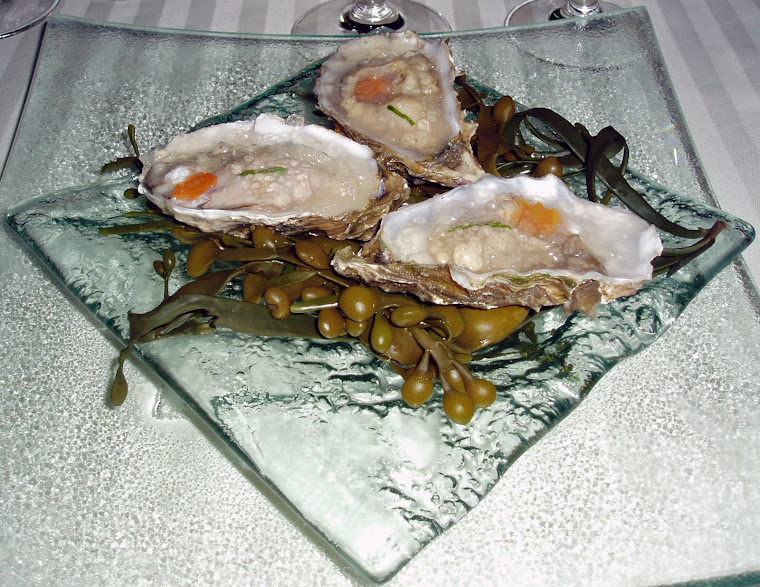
Sautéed Greens & Blue Cheese
(Photo - RLW - Chef picking greens, Auberge du Bois Prin, Chamonix by Mont Blanc, France)
Some of the healthiest dishes you can prepare are leaf vegetables, or greens. I have been experimenting with different combinations of greens and discovered to my pleasant surprise that delicious side dishes can result.
Try to find fresh greens at a local farmers market, grown and picked locally. The key is that they be richly green and absolutely fresh. Prepare them the same day you buy them.
Typically available greens are spinach of course and members of the Cruciferae family, kale and collards (both Brassica oleracea var. acephala). Unlike cabbage (Brassica oleracea var. capitata), neither kale nor collards forms a head—thus the name "acephala" which means 'forming no head'. Kale and collards are the oldest forms of cabbage and are native to the eastern Mediterranean region of Europe or to Asia Minor. The use of kale as a food dates to 2000 B.C.E. or earlier.
Nutritionally greens are super foods vis-à-vis their weight and cost. A serving (1½ cups) of cooked spinach has forty calories and provides 70 percent of the recommended daily allowance (RDA) for adults of vitamin A, 25 percent of the RDA of vitamin C, and 20 percent of the RDA of iron. Spinach also contains high levels of calcium, phosphorus, potassium and it has moderate levels of protein. A serving of Swiss chard (3½ oz.) provides 130 percent of the adult RDA of vitamin A and 25 percent of the adult RDA of vitamin C.
Other great choices are from the Broccoli raab (Brassica campestris) family, also known by such names as raab, rapa, rapini, broccoli turnip, spring broccoli, cima di rapa, taitcat, Italian turnip, and Italian mustard. It is a highly regarded leaf green in Italy and other Mediterranean countries.
Experiment and enjoy!
1 large clump of greens; fresh spinach, kale or Broccoli raab
1 medium head of broccoli
1 large Vidalia onion, sliced thinly
1 cup of fresh basil leaves
1 Pablano pepper, roasted, deseeded, skinned and sliced
¼ cup pine nuts, briefly sautéed on high heat
½ cup crumbled blue cheese
1 tablespoon of freshly squeezed lemon juice
1 tablespoon of butter
1 tablesoon of olive oil
Salt and ground pepper to taste
Preparation:
1. Clean and prepare the greens, chopping the leaves in bite-sized pieces. If the stems are large and tough, reserve them for another usage (such as a stew vegetable). Or you can thinly slice the stems and use them in the dish, your choice. Thinly slice the Vidalia onion. Place both in a large bowl of cold water, adding a splash of lemon juice and apple vinegar and reserve.
2. Separate the broccoli flowerets and place in a large pot of salted water and reserve.
3. Roast the Pablano pepper on the grill or under the broiler until the skin is blackened. Wrap the pepper in a kitchen towel and cool. Remove the skin of the pepper, running cold water on it occasionally to speed the process. Remove the stem and interior white flesh and seeds. Slice thinly in one inch strips and reserve.
4. Bring the broccoli flowerets to a quick boil and immediately remove and submerge in cold water.
5. Sauté the pine nuts in a fry pan until just golden brown; about two minutes.
6. In a wok or large stir-fry pan melt the butter and add the olive oil. Drain the greens and onion slices and shake off excess water. Carefully place them into the wok. On high heat briefly toss the vegetables for one minute and turn off the heat. 6. Drain the broccoli flowerets and add to the vegetables in the wok. Add the basil leaves, pine nuts, Pablano pepper strips, and the crumpled blue cheese. Splash on a tablespoon of lemon juice and a drizzle of olive oil. On high heat toss the mixture several times as the vegetables sizzle; not more than a minute or two. Do not overcook! The greens should still be crisp and firm. Salt and pepper to your taste.
Presentation: Sautéed greens are delicious with just about any meat or fish course, but roasted pork tenderloin or a simple meat loaf work just fine. Serving this on top of slices of freshly toasted bread is delicious as well - like a bruschetta.
Richard Wottrich


